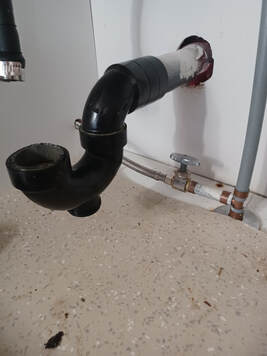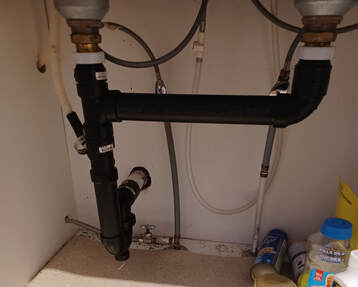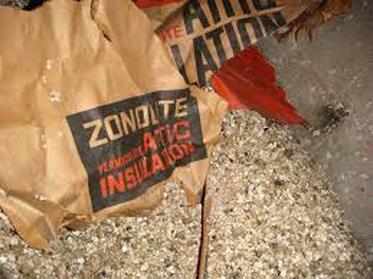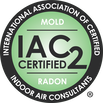Mike's Home Inspector BlogMichael Burfitt |
|
I had an incident recently where our kitchen sink was suddenly not draining. Before this event, we had no issues whatsoever when using the faucet. I tried the usual methods: snaking both sides of the sink, using drain cleaner, and pouring hot, soapy water down the drain. Nothing seemed to work, and the slow drain continued. Eventually it became clear that the entire drain system visible under the sink would have to be completely removed and replaced, as acrylonitrile butadiene styrene (aka ABS) is not generally feasible to repair. Upon dismantling the plumbing I quickly found out what the problem was. I was going to post detailed pictures of the issue, but I want you to hold onto your lunch today. Essentially, the top of this p trap (where the black pipe meets the part with white paint) was nearly completely clogged with a disgusting brown sludge known as a fatberg. This should not happen under normal operation, so I went to investigate further. I quickly discovered that the previous owners of our home had washed what appeared to be 2 long bamboo sticks down the sink. Over time, these sticks grabbed onto food and other particles and led to a reduction in water velocity going to the main drain line. As a direct result, the sludge was not forced down to the main line and slowly built up over time.
Much like Radon and Asbestos, being careless about putting items that don’t belong down the sink, such as grease or sticks, isn't likely to cause any short-term issues. However, the cumulative effects can come years down the road, often with little to no warning. If you were to tell me the week before I took the drain apart that it was full of sludge, I would not believe you, but the evidence was clear as it was obvious why our sink was not draining properly. The plus side is that we now have a clean slate, where we can be careful not to have this incident repeat. While it wasn’t an expensive fix (about $100 total), it was not fun having to spend a Monday evening (and into Tuesday morning) making this emergency repair, all while having a counter full of dirty dishes. Many homeowners believe that small, careless decisions or neglect of their home won’t make much difference to them in the long run. This may be true during their time of ownership of the home, however it will eventually result in issues. Our clogged sink started slowly building up years ago and although we could not have seen this when we moved in, many other preventable surprises can be detected with a home inspection. Different areas of North America tend to favor one specific type of house siding and Nova Scotia is no exception. In this week’s blog post, we look at some of the most common types of siding seen in our province. Vinyl Siding This is the most popular choice in North America (about 1/3 of all installations) and is the overwhelming choice for homes in Nova Scotia. It has largely replaced wood and metal siding due to its combination of value, durability and lack of required maintenance. Not only does vinyl siding not need to be painted, but the colour goes all the way through the material and doesn't just cover the surface, meaning a scratch or other minor damage will not affect its appearance. Home inspectors look at several concerns such as signs of waviness, joints not staggered properly (a clear sign of poor or amateur installation) and proper detailing around windows, doors, and other penetrations. While relatively easy to install, it still takes skill to do properly. It has recently come to my attention that in my subdivision, the installation techniques were far from high quality, a fact I can personally attest to that when in 2018 we lost a significant amount of siding. These deficiencies can be hard to detect during a standard home inspection. Masonry (Brick, Stone & Concrete) I have previously covered this type of siding in a previous blog post. Inspectors look for signs of spalling, mortar deterioration and bowing walls (more common in older installations). In my experience these are usually quality installations by skilled masons and are generally well maintained. Wood Shingles and Shakes Most wood siding is composed of cedar due to its rot resistance. Other species of wood can be used (such as pine) but it requires additional preservatives to protect against rot. Wood siding also requires regular maintenance (such as painting or staining) and has little in the way of fire resistance. There are many different types of wood siding installation:
Asbestos Cement/Fiber-Cement Asbestos is a scary word and as a result asbestos cement siding has received an unfair bad reputation. As can be seen on my previous posts on asbestos, it is only dangerous in a friable state. Translation: there is no danger if the siding is not disturbed by heavy mechanical damage. Overall, it is a good siding material but since it was discontinued many years ago properly repairing it may be difficult, if not impossible. Modern versions of fiber-cement are commonly known by its main trade name Hardie board. It has many of the advantages of asbestos siding without the…. you know…. asbestos. It can be very hard to tell apart from wood and possibly my single biggest goof up as a home inspector was mistaking Hardie board for wood siding. It was located only in a specific area of the home on the second level and it taught me to always verify my visual observations by touch as much as humanly possible. Stucco/EIFS
Even though these two systems look identical, they are quite different. They are also common…. in commercial settings. Despite being very common on homes in other areas of North America, they are very rarely seen on houses in Nova Scotia. I actually had to do some research on these two types of siding and why they aren't more common, to which I will share my findings in next week’s blog. It seems like every single home renovation show has a segment where the client expresses their love for having an open concept home. A few scenes later, out come the sledgehammers and within a few minutes we see a wonderfully clear, open room. If only it was that easy! I am a home inspector and not a building contractor, but I certainly can tell you without any hesitation that tearing out a wall is far messier and more expensive and disruptive than any TV show implies. As a general rule, I personally am not a fan of open concept design and here are some reasons why I believe you should think twice before taking part in this type of renovation.
Load Bearing Walls Contrary to some horror stories you may read of load bearing walls being cut down, in most modern homes the roof is constructed using engineered trusses, which generally do not require support (for the top level of the house only) aside from the exterior walls. However, in Nova Scotia and most area of North America only a licensed engineer can certify a wall is not load bearing. There are lots of articles online about how to identify a load bearing wall, but it is not always as simple as an internet search. Plumbing & Electrical When plumbing and electrical systems were originally installed, no thought was given to what the home would look like 30, 40, or 50 years into the future. A lot of these shows make it look like a simple 2-hour job to move some wires and pipes when in reality, it can be a very difficult and expensive task. These two systems have to be engineered carefully and relocating these features is not as simple as simply adding new pipes and wires. There is a very good reasons plumbers and electricians are expensive and it isn't because they are just greedy. Houses are Designed to Have Zones Modifying the structure can affect the home’s HVAC (Heating, Ventilation and Air Conditioning), as these systems were designed with walls and separation in mind. Not only can energy flow be disrupted and possibly require remediation but there is no longer a way to “seal off” specific rooms. For example, in our home the kitchen heat can be turned low after supper to save energy, but this is not generally possible in an open concept house. There is also the issue I see in some flipped houses where the stove is moved from an exterior wall towards a more central location. Rarely is the ventilation factored in and while it actually is NOT required by any building codes, it won’t take long for the lack of a kitchen fan to become unpleasant. NOISE! We always have a child and sometimes more than one in our house. As great as kids are, there can be no doubt they are noisy. With an open concept house, the sounds of children (or their favourite shows) can travel throughout the home. Asbestos Any home built before the 80s almost always has asbestos in it. While generally harmless if left alone, it becomes very dangerous when disturbed. Always assume any home built before the 80s has asbestos in the walls until proven otherwise. For these reasons and many more, it is important to think twice before knocking down walls. TV shows are designed to provide a WOW factor but as a homeowner, unforeseen issues can develop after the sledgehammers are brought in and the walls come down. Like many homeowners, I have watched plenty of home related TV shows over the years. I have also mentioned previously that I have an overall positive opinion of Mike Holmes although I can certainly think of plenty of valid criticisms regarding his various shows, mostly revolving around how he blurs the line between construction and inspection. So, it goes without saying that I was excited to hear about a show focusing on home inspections starring an actual home inspector. How awesome to see our relatively unknown industry getting its own show and getting to showcase what a home inspector does and why it's important to get a home inspected! Now that I have had a chance to see a few episodes I think I have seen enough to form a fair opinion.
The show features Joe Mazza, a home inspector from New York state who definitely has a personality fit for TV even though he is a rookie to that medium. What do I think of his show? In my opinion it is a significant misrepresentation of our industry to put it mildly. Of course, actual inspection jobs would not translate well to TV, as they can take an average of over 2 hours just on site alone and can require plenty of detailed explanations of technical issues in layman's terms. My criticisms are many and mainly revolve around how Joe, who to my knowledge is an actual licensed inspector in both New York and Connecticut, does very little actual inspecting (it’s more of a show about house hunting and renovations) and much of what he states is misleading at best and flat out wrong at worst. Let me count some of the numerous issues I see just from a few episodes: Much of the Show is Outside the Scope of a Home Inspection Joe is seen to be touring the homes with Noel Gatts, an interior designer. Simply put, we home inspectors do not generally inspect or comment on cosmetic finishes and while it is no doubt a valuable profession, we do not “team up” with interior designers on our inspections to recommend cosmetic work. We Do NOT Tear Out Walls or Do Renovation Work I’m not sure what the standards in New York or Connecticut are, but all major home inspection organizations make it very clear that it is a serious ethical violation to perform repairs or renovations to any home within 1 year of performing an inspection. This show also makes the connection that home inspectors are just contractors that do inspections on the side or are just inspecting to look for ways to make money renovating. While a person can certainly do both jobs successfully, in my experience they require VERY different skillsets. We also are not invasive in our inspections, and as fun as being destructive can be I definitely do not bring a sledgehammer with me! We Don't Make Definitive Statements in Most Circumstances This show has many scenes where Joe says something like “that’s asbestos!” or “that’s black mold!”. While there are signs that something is very likely asbestos or mold, only a lab test can confirm it! I also got upset when while tearing out a wall, one of the workers quickly and confidently states, “this wall isn’t load bearing!”. While I agree it likely isn’t, in most areas (including here in Nova Scotia) only a qualified engineer or architect can make that statement and it can cause serious, if not catastrophic damage to remove a load bearing wall. The Show Has Very Little to Do with Home Inspections Overall, the show only dedicates a tiny fraction to actual home inspection work. It is unfortunate that a show that could have highlighted our industry and the incredible work I and my fellow inspectors do is just another dime-a-dozen renovation show with “Home Inspector” slapped on the title. It does a disservice to both our industry and our clients by providing very misleading information of what a home inspector does. I love to watch home inspectors in action, but this show is not an example of what we do. One of the great things about being the founder and president of a small company is that I can handle many of the business tasks myself and nearly everything is handled by our family. This gives me great freedom to provide outstanding value and go the extra mile (or 1.6 kilometres if you prefer). I personally answer all calls, read all texts and emails, and give clear answers to all inquiries even if I believe another professional would be better suited for your needs. It is great to be free to speak without following a corporate script but there are a few phrases you will never hear me (and hopefully no other home inspector) utter.
This House is Overpriced/A Great Deal/Just Right I certainly have personal opinions on the current housing market, but they are just that: personal. As a professional home inspector who also completed a business degree, I have extensive training in the subject of making optimal financial decisions within budget constraints. However, this is beyond the scope of an independent home inspector. You will never hear me advise whether you should buy a house or not, but I will alert a client if I believe their expectations are greatly misaligned with my observations, such as expecting a turnkey home when it needs extensive maintenance. The Home is Full of Dangerous Mold/Asbestos Contrary to popular belief, there is no way to identify ‘toxic’ mold or asbestos from a visual examination alone. Are there signs that a house almost certainly has issues with either? Absolutely but there is no way to be 100% sure without a lab test. While beyond the standard of a home inspection I usually alert my clients if further testing or evaluation is recommended but you will never see me make any definitive statements because they simply cannot be made in the field. Call Me to Fix This Issue One of the many requirements of being a member of InterNACHI (the International Association of Certified Home Inspectors) is to follow their code of ethics (InterNACHI Code of Ethics). This is more than a meaningless platitude: everyone who is affiliated with our company is expected to follow it without exception. One such requirement is to avoid all real or perceived conflicts of interest. Therefore, while I fancy myself a bit of a handyman, we InterNACHI members are not permitted to perform repairs for an extra fee for 12 months. Yes, I will occasionally tighten a loose screw or clear a gutter blockage if I am safely able to, but you will never see me charging extra. The inspection fee is the only price I charge and if the inspection takes far longer than expected you still don’t receive any additional invoice or other hidden charges. Please Listen Closely to Our Menu Options Few things annoy me more than calling a company and having to navigate unclear menus only to be sent to the wrong department. Amazingly these same companies almost always have a ‘higher than normal’ call volume and my ‘call is important’ despite spending significant time on hold. While I am frequently away from the phone, make no mistake I will always call back as soon as possible and will give you a clear answer to your inquiry. I am aware that the majority of people calling me can be under a great deal of time pressure and stress, whether it be because they are dealing with the various steps of a real estate transaction, dealing with one of the many issues that being a homeowner can throw at you or are worried about a potential structural problem you can rest assured that we will not add to that stress and can give you clear, immediate answers without having to deal with a headache inducing call centre. Like most Canadian home inspectors, I have been asked on occasion what I think of Mike Holmes. Overall I have a positive opinion of him and have learned plenty watching his many shows over the years. My biggest criticism, however, is that he tends to exaggerate relatively minor issues and unintentionally misrepresent how easy it is to renovate a home, which given the limitations of television is understandable.
Before I became a professional home inspector, I imagined it was a lot like a TV show, where I look at an issue and loudly proclaim: “this is X, will cost Y and will take Z to complete!” The truth is that while some issues are black and white (i.e. missing safety devices) many defects I come across require me to draw upon my vast knowledge of building systems to evaluate. Here are just a few examples of symptoms that can be anything from cosmetic to catastrophic. Foundation Cracks One of the most concerning things a homeowner can face is a home that is sinking on one side. This can be a very expensive repair and in extreme situations it may even be cheaper to rebuild the entire house! While that sounds terrifying in reality this is a rare situation: nearly every home has foundation cracks and they are generally not a big deal. There are a number of variables I look at:
Sewage Smell Methane gas is not only unhealthy and explosive in large concentrations but smells terrible and can be very concerning. If a home smells of sewage, this could mean a sewer line clog or even worse, a break. Both are expensive to remedy and are very disruptive to a home’s occupants. Before waving the white flag and calling for a plumber, an inspector knows to check a few things first, particularly the home’s toilets. These are the only fixtures where the waste pipes do not have a trap to prevent sewer gas from escaping (they are in the toilet itself) and over time the wax seal keeping it in place to the floor will crack and loosen, leading to the unpleasant smell. This is a relatively minor repair and can be completed by the homeowner or a handyman. Potential Asbestos I recently had a real estate agent ask me how much of a concern Asbestos is for home buyers. The short answer is that it depends on where in the home it is located. If you follow this blog, you already know that Asbestos is very dangerous to long term health but only when in a friable (easily crumbled) state, where loose fibres can coat the lungs over time. If a house has asbestos (and a significant number of homes, particularly on the Halifax Peninsula or Downtown Dartmouth likely do), my advice will vary based on where the potential asbestos is located. If it is discovered in flooring tiles or siding the best option would be to leave it alone but it is in insulation, I generally suggest either covering or preferably having a qualified abatement contractor remove it. Ideally, I would love to wave a magic wand and remove all asbestos from homes but in reality, it is very expensive and time consuming to completely remove asbestos safely from a structure. Just like a doctor will usually suggest not searching the internet for symptoms, as a homeowner you should be cautious when looking at information online. There is a lot of scary information about topics such as Polybutylene Pipes, Flammable Insulation and Dangerous Decks but reality is far more subjective than the blanket statements I often see. These symptoms can suggest a wide variety of conditions but in my experience, they are usually on the mild end of the spectrum.
|
Archives
July 2024
Categories
All
|
|
Inside Edge Home Inspections Ltd.
Halifax, NS 902-209-9921 [email protected] Proudly Serving the HRM & Central Nova Scotia |





 RSS Feed
RSS Feed

